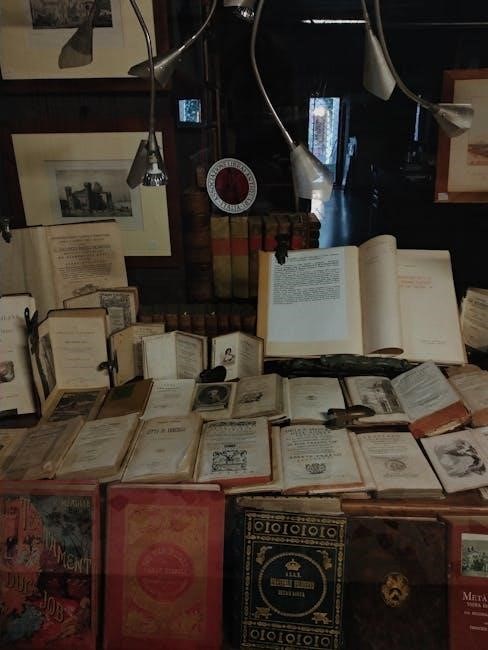
The AP World History textbook PDF is a valuable resource designed to guide students through the complexities of world history, offering comprehensive coverage, chronological organization, and essential study tools.
Overview of the AP World History Course
The AP World History course is a rigorous, college-level program that explores the history of the world from approximately 1200 CE to the present. It emphasizes the development of historical thinking skills, including analysis, argumentation, and synthesis. Students analyze key themes such as humans and the environment, cultural developments, governance, and economic systems. The course is divided into nine units, each focusing on specific time periods and global interactions. Textbooks like The Earth and Its Peoples and the AMSCO AP World History textbook provide comprehensive resources, though some students find the level of detail challenging. The course culminates in an exam that assesses knowledge and critical thinking abilities. By mastering the material, students gain a deeper understanding of global patterns and connections, preparing them for advanced academic pursuits.
Importance of Using Textbooks in AP World History

Textbooks are essential resources for mastering the AP World History curriculum, providing structured, in-depth coverage of historical events, themes, and concepts. They offer a comprehensive narrative that connects global patterns and processes, helping students build a foundational understanding of world history. Textbooks like The Earth and Its Peoples and the AMSCO AP World History textbook are widely recommended for their detailed explanations and chronological organization. These materials guide students through complex topics, such as humans and the environment, cultural interactions, and governance, while also emphasizing historical thinking skills like analysis and argumentation. Additionally, textbooks include study tools like unit guides and learning objectives, which help students track their progress and prepare effectively for the AP exam. By using textbooks consistently, students can develop a deeper understanding of historical contexts and improve their critical thinking abilities.

Course Content
The AP World History course spans from c. 1200 CE to the present, exploring themes like environmental interactions, cultural developments, governance, and economic systems across global regions.
Historical Periods Covered
The AP World History textbook PDF covers a broad timeline, beginning with prehistory and early civilizations, followed by the rise of complex societies. It explores the medieval period, the Age of Exploration, and the impact of global interactions. The textbook delves into the early modern era, focusing on state-building, cultural exchanges, and economic systems. It also examines the modern period, including the Industrial Revolution, colonialism, and the interconnectedness of the contemporary world. Each historical period is presented with detailed analysis, highlighting key events, cultural developments, and their lasting legacies. By organizing content chronologically, the textbook helps students understand the progression of global history and the connections between different eras. This structured approach ensures a comprehensive understanding of how historical events have shaped the modern world.
Key Themes and Concepts
The AP World History textbook PDF emphasizes several key themes that are central to understanding global history. These include humans and the environment, cultural developments and interactions, governance, economic systems, and social hierarchies. The textbook explores how these themes have evolved over time and across different regions. It also highlights the interconnectedness of the world, emphasizing global interactions and their impact on historical developments. Students are encouraged to analyze how these themes shape historical events and cultural practices. By focusing on these key concepts, the textbook provides a framework for understanding the complexities of world history and helps students develop a nuanced perspective on global dynamics. This thematic approach ensures that learners can connect broader patterns to specific historical contexts, fostering a deeper comprehension of the subject matter.
Geographical Coverage
The AP World History textbook PDF provides extensive geographical coverage, spanning across various regions and civilizations worldwide. It explores the history of East Asia, the Americas, Europe, Africa, and the Middle East, offering a balanced perspective of global developments. The textbook emphasizes the interconnectedness of these regions, highlighting how events in one area influenced others. It delves into the rise and fall of empires, cultural exchanges, and the impact of environmental factors on human societies. By examining diverse geographical contexts, the textbook helps students understand the complexities of global history. This comprehensive approach ensures that learners gain a well-rounded understanding of historical events and their geographical significance. The textbook’s focus on both regional and global perspectives makes it an invaluable resource for studying world history.

Textbook Structure
The AP World History textbook PDF is structured with an introduction, chronological organization by historical periods, detailed unit guides, and clear learning objectives for each section.
The AP World History textbook PDF begins with an introduction that outlines the course framework, historical periods, and key themes, providing students with a clear roadmap for their studies. The acknowledgments section recognizes contributors, reviewers, and educators who helped shape the textbook, ensuring its academic rigor and relevance. This introductory portion also includes a preface that explains the purpose and structure of the textbook, helping students understand how to navigate its content effectively. Additionally, the introduction highlights essential study strategies and resources, such as timelines, maps, and primary sources, to enhance learning. By starting with these foundational elements, the textbook equips students with the tools and perspective needed to tackle the complexities of world history. This section is designed to engage learners and set the tone for a comprehensive and enriching educational experience.
Chronological Organization
The AP World History textbook PDF is organized chronologically, spanning from approximately 1200 CE to the present day. This structure allows students to trace historical developments and connections across time and regions. The textbook is divided into distinct periods, such as the Global Tapestry (1200–1450), Networks of Exchange (1450–1750), and Revolutions and Empires (1750–1900), ensuring a logical progression of content. Each period is further subdivided into units that explore specific themes, events, and transformations. This chronological framework helps students build a coherent understanding of global history, enabling them to analyze patterns, causes, and effects over time. The textbook also includes timelines, maps, and primary sources to reinforce this temporal organization, making it easier for students to follow and engage with the material. This approach ensures that learners can connect historical events and ideas seamlessly, fostering a deeper appreciation of world history.
Unit Guides and Learning Objectives
The AP World History textbook PDF includes detailed unit guides that outline the structure and content of each historical period. These guides are aligned with the AP course framework, ensuring students meet the learning objectives. Each unit begins with a clear overview, followed by specific topics and key concepts, helping students focus their studies. Learning objectives are explicitly stated, enabling learners to track their progress and understanding. For example, Unit 1 focuses on “The Global Tapestry,” exploring interconnectedness and cultural exchange from 1200 to 1450. The guides also incorporate historical thinking skills, such as analyzing primary sources and causation. By aligning content with objectives, the textbook ensures a structured approach to learning, making it easier for students to master the material and prepare for the AP exam. This organization supports both independent study and classroom instruction effectively.

Benefits of Using the Textbook
The AP World History PDF offers comprehensive coverage, enhances historical thinking skills, and provides structured exam preparation, making it an indispensable study resource.
Comprehensive Coverage of Historical Events
The AP World History textbook PDF provides an extensive exploration of historical events, spanning from c. 1200 CE to the present. It meticulously covers key periods, such as the rise of global networks, industrialization, and modern tensions, offering detailed narratives and primary sources. The textbook emphasizes connections across regions and themes, helping students understand the broader context of historical developments. By integrating diverse perspectives, it ensures a balanced view of global history, making it easier for students to grasp complex interactions between cultures, economies, and political systems. This comprehensive approach not only builds foundational knowledge but also encourages students to analyze patterns and continuities over time, fostering a deeper understanding of the world’s past and its relevance to contemporary issues.

Development of Historical Thinking Skills
The AP World History textbook PDF is designed to cultivate critical historical thinking skills, enabling students to analyze complex events, interpret sources, and construct well-supported arguments. Through structured units and guided inquiries, the textbook encourages students to consider multiple perspectives, evaluate evidence, and synthesize information. It emphasizes the development of skills such as contextualization, causation, and thematic analysis, which are essential for success on the AP exam. Interactive features like primary source analysis and practice questions help students apply these skills to real historical scenarios. By engaging with the textbook, students build the ability to think critically about the past and its relevance to the present, fostering a deeper understanding of global historical processes and their interconnectedness. This skill-based approach prepares students not only for academic success but also for lifelong learning and informed decision-making.
Preparation for the AP Exam
The AP World History textbook PDF is a cornerstone for effective preparation for the AP exam, offering a structured approach to mastering the course material. It includes practice questions, sample essays, and scoring guidelines that mirror the exam format, helping students familiarize themselves with the types of questions they will encounter. The textbook aligns with the AP course framework, ensuring comprehensive coverage of all nine units and historical periods. Additionally, it provides strategies for tackling free-response questions and document-based essays, which are critical components of the exam. By using the textbook, students can identify areas for improvement and refine their test-taking skills. The inclusion of past exam questions and detailed explanations enables students to assess their understanding and build confidence. This resource is indispensable for achieving success on the AP World History exam.

Digital Version
The AP World History textbook is available in PDF format, offering convenience and accessibility. It enhances learning with digital tools, enabling easy navigation and keyword searches.
Advantages of the PDF Format
The PDF version of the AP World History textbook offers numerous advantages for students. It provides easy access to course materials anytime, anywhere, eliminating the need for physical copies. The digital format allows for keyword searches, enabling quick navigation to specific topics or concepts. Students can highlight and annotate pages, making it easier to engage deeply with the content. Additionally, the PDF is environmentally friendly and cost-effective compared to traditional textbooks. Its portability ensures that students can study on multiple devices, enhancing flexibility. The PDF format also supports interactive features, such as hyperlinks and embedded resources, which enrich the learning experience. Overall, the digital version is a practical and efficient tool for mastering the complexities of world history and preparing for the AP exam.
Accessibility and Convenience
The PDF version of the AP World History textbook offers unparalleled accessibility and convenience for students. It can be accessed on multiple devices, including laptops, tablets, and smartphones, making it ideal for on-the-go studying. The digital format is easily downloadable, ensuring that students can access course materials even without an internet connection. Additionally, the PDF is compatible with assistive technologies, such as screen readers, making it inclusive for students with disabilities. The ability to search and navigate through the document quickly enhances study efficiency. Furthermore, the PDF can be shared and stored securely, reducing the risk of losing physical copies. These features make the digital textbook a practical and flexible resource for students aiming to succeed in their AP World History studies.

How to Effectively Use the Textbook
To maximize the AP World History textbook PDF, adopt a structured approach: read actively, take detailed notes, and outline chapters for clarity. Regular self-assessment through practice quizzes and review questions will reinforce understanding. Utilize digital tools for annotation and organization, and explore supplementary materials for deeper insights. Maintain a consistent study routine, balancing active reading with strategic use of resources to stay motivated and engaged throughout the course.
Reading Strategies
Effective use of the AP World History textbook PDF requires a strategic approach to reading. Begin by skimming introductions and conclusions to grasp the main ideas. Focus on key sections highlighted by the author, such as thematic overviews and historical debates. Use headings and subheadings to guide your reading and identify critical concepts. As you read, actively engage with the material by highlighting important points and jotting down questions or insights in the margins. After each chapter, take a few minutes to summarize the content in your own words to reinforce understanding. Regular self-assessment is crucial; test your knowledge with practice quizzes or review questions provided in the textbook or online. Additionally, revisit difficult sections and seek clarity through supplementary resources or discussions with peers. Consistency and active engagement are key to mastering the material.
Taking Notes and Outlining
To maximize the effectiveness of the AP World History textbook PDF, develop a structured note-taking system. Highlight key terms, events, and concepts as you read, using symbols or abbreviations to save time. Organize your notes chronologically or thematically, aligning them with the textbook’s units and periods. Create detailed outlines for each chapter, breaking down major themes, causes and effects, and historical developments. Use bullet points or mind maps to visually represent relationships between ideas. Regularly review and update your notes, ensuring clarity and completeness. This process not only aids retention but also serves as a valuable study resource for the AP exam. By maintaining organized and comprehensive notes, you can efficiently master the course content and prepare for success.
Self-Assessment and Practice
Self-assessment and practice are essential for mastering the AP World History curriculum. Regularly test your understanding by answering practice questions in the textbook or online resources. Use the PDF’s built-in review sections or supplementary materials to gauge your knowledge. Identify weak areas and revisit relevant chapters or notes for clarification. Engage with past AP exam questions to familiarize yourself with the exam format and timing. Reflect on your performance to refine study strategies and improve historical thinking skills. Additionally, utilize digital tools or apps to track progress and set realistic goals. By consistently practicing and assessing your understanding, you can build confidence and readiness for the AP World History exam. This proactive approach ensures a deeper grasp of the material and better preparation for success.

Finding the Textbook
The AP World History textbook PDF can be found through official College Board resources, educational databases, or online archives like Annas Archive or LibGen for convenient access.
Official Sources
The College Board is the primary source for obtaining the AP World History textbook PDF. Students and educators can access it through the official AP Central website, which provides authenticated resources. Additionally, the AP World History: Modern course framework and related materials are available for download. Many educational institutions offer access to the textbook through their online portals or libraries. To ensure authenticity, it is advisable to download the PDF directly from these official platforms. The College Board ensures that the content is accurate, up-to-date, and aligned with the course curriculum. Accessing the textbook through official sources guarantees that students receive the most reliable and comprehensive study materials. Always verify the source to avoid unauthorized or incomplete versions of the textbook.

Alternative Platforms
For students unable to access the textbook through official sources, alternative platforms like Annas Archive and LibGen offer free PDF versions of the AP World History textbook. These platforms aggregate educational resources and provide access to a wide range of academic materials. However, users should be cautious about the legality and reliability of these sources, as they may not always offer the most updated or complete versions. Additionally, some textbooks on these platforms may be shared without proper authorization. While these alternatives can be helpful, they should be used with discretion. Always prioritize official sources for the most accurate and legally compliant materials. If alternative platforms are used, ensure the content aligns with the course requirements and is free from unauthorized modifications.
The AP World History textbook PDF serves as an invaluable resource for students navigating the complexities of world history. By providing comprehensive coverage of historical periods, key themes, and essential skills, it equips learners with the tools needed to excel in the AP exam. The textbook’s chronological organization and inclusion of study aids like unit guides and practice questions make it a cornerstone of effective preparation. While official sources remain the most reliable way to access the textbook, alternative platforms offer flexible options for students seeking convenience. Ultimately, whether in physical or digital form, the AP World History textbook is a fundamental tool for understanding the global past and its relevance to the present. By leveraging this resource alongside supplemental materials and active study strategies, students can achieve success in their academic journey.
 norwegian sun deck plan pdf
norwegian sun deck plan pdf  free disc personality test pdf
free disc personality test pdf  body language pdf
body language pdf  aperture shutter speed iso chart pdf
aperture shutter speed iso chart pdf  valentía 2 libro pdf descargar gratis
valentía 2 libro pdf descargar gratis  kenmore oven manual model 790
kenmore oven manual model 790